This two part series is a complete guide for retail owners, buyers and sales professionals that details leather features, benefits and advantages. It also includes best retail practices from a panel of industry experts who generously provided Furniture World with tips on marketing, selling, training product knowledge, and servicing leather.
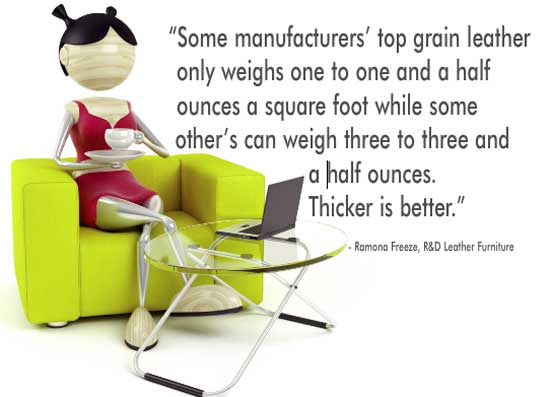
LEATHER HISTORY
Like stone, wood and wool, leather is a natural product. It has been a prized commodity throughout history. All of the earlier Renaissance styles, particularly the Spanish and English favored leather upholstery. Techniques for embossing, tooling, painting and gilding leather were disseminated by Spanish craftsmen in the 16th and 17th centuries. Throughout this period, all types of furniture were covered with leather and studded with decorative nail-head patterns. In the 18th century, the art of preserving hides and tanning them into leather had become an old, respected trade. The tanning process took almost a year and was completed by coating the hides with oil and grease, then scraping and treading on them. Oxhide and calf skins were a favorite in the late Louis XIV styles, and fine goat leather was often used by Chippendale and subsequent designers. Then, as today, cattle hides were the major leather source because of their availability, strength and hide size.
LEATHER FEATURES
From a consumer standpoint, buying a leather sofa can seem like a “no-brainer”. There are no fabric patterns to choose, simplifying decorating decisions for the design-challenged. It is also true that quality leather has properties which can make it superior to many fabrics. Consider the following:
- Leather outlasts most fabric coverings. It has an exceptionally long useful life.
- It will not tear and is half again as strong as other upholstery materials -- even along the seam lines.
- It is fire resistant and emits no toxic fumes, even when exposed to intense heat.
- Modern full grain leather products won’t crack or peel.
- Quality leather stretches and retains its shape without sagging.
- It "breathes", assumes body temperature rapidly and is instantaneously comfortable.
- It resists heat and sun damage.
- Leather is a practical material, ideal for busy lifestyles. No special solvents or cleaners and no lengthy or expensive procedures are necessary for its care.
- Leather generally ages well.
On the other hand, depending on how it is used, covers promoted and sold as leather differ in how long they will last, how easy they are to clean, in their suppleness and, how effectively they can be repaired. There are big differences in leather price, quality and wearability, yet retail customers may have trouble evaluating how these differences correlate with desired benefits. This isn’t surprising since even retail salespeople who should have this expertise, may not be conversant with the types of leather, finishes or products such as leather splits, vinyl and fabric/leather composite materials.
Although home furnishings industry professionals do not need to know the fine details of leather production, basic information regarding hide quality, tanning, dyeing and finishing can help retailers to steer customers toward making informed purchase decisions.
Product Knowledge: There is quality to be had at all price points. And, what seems like a good value for one customer may turn out to be a disaster for another when it comes to leather. This is the reason why retail salespeople who sell higher end goods need to know why their products are worth more, and why those who sell more promotional products should be able to explain why their wares are a good value.
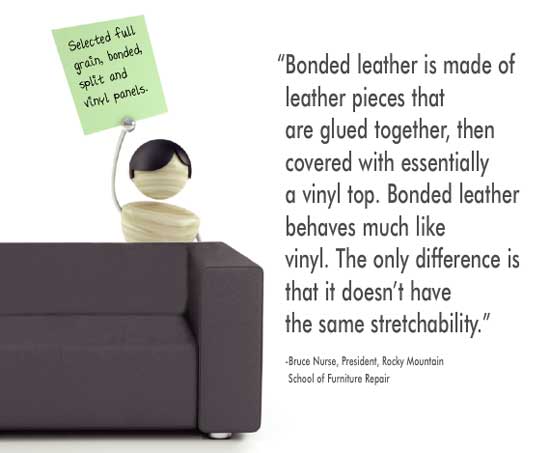
“A lot of education is required to sell leather,” notes Paul Gonzalez, CEO of the leather specialty chain Texas Leather Interiors.
Jim Riedl, President and CEO at Arizona Leather Company with 16 locations in California, Arizona and Georgia agrees. “We tout ourselves as the leather experts,” he explains. “When we bring somebody onboard, we make sure that they are well equipped to answer the customer’s questions. Unfortunately, across our industry, there is really no standard in leather furniture, to compare apples to apples. So, we have to define for our clients the differences between a particular product found elsewhere and ours. That’s because in general, the information our clients are getting out there is not just inaccurate, but completely false.”
“I think that educating sales associates about the product that they’re selling is number one,” confirms Ramona Freeze, President of California based R&D Leather Furniture. “As a leather specialist it’s easier because we focus on just one product. Our people know how the leather is processed, all about construction, the thickness of the leather, how much it weighs per square foot, and how much pressure it can take per square inch. Having this information makes our salespeople so much more confident and it adds to their enthusiasm when customers also get excited by this information. But,” adds Freeze, “we don’t overload customers with information. If we’re working with a housewife, we use terms and words she knows such as cleanability, durability, color, style and comfort.”
KINDS OF LEATHER
All leather is the product of animal hides, however, these vary in their quality and the ways in which they are converted into leather. High quality leather is expensive. The raw material cost represents a substantial percentage of the total cost of manufacturing leather upholstery.
Animal hides are converted through a many step process which preserves, softens, beautifies and protects the finished product. Only a small percentage can be used to make upholstery leathers which must have large sections free from serious blemishes. Whereas it takes only a small piece of leather to make a good shoe; a sofa cushion requires a large panel of high quality.
Top & Full Grain: As part of the involved upholstery leather preparation process, suitable animal hides are split into a top layer (the one which had hair on it) and a thick lower layer.
The top layer, also called top grain, can either be processed into full grain leather which is not buffed and sanded; or into corrected grain leather that has had the surface markings altered by buffing and sanding.
Generally, leather that has too many surface imperfections (too much character) will require correction. Full grain leather, is considered to be of greater beauty and higher quality than corrected grain leather, and so commands a higher price.
Splits: The lower layer may then be further split and processed into suede split or coated split leather. Coated split leather is somewhat stiffer and less durable than top grain leather. It is sometimes used to cover upholstered sides and backs that do not need to flex and move much.
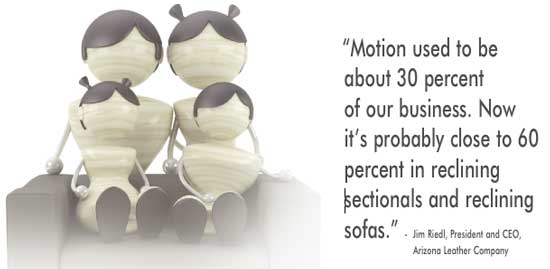
TRIMMING COSTS
As the popularity of leather upholstery has increased, so has the demand for less expensive options. Manufacturers may do this by covering sides and backs with less expensive splits, use bonded leather products or matching vinyl panels.
At retail, consumers may not be able to readily tell when side and back panels are not full grain, because alternative products have aesthetic properties roughly comparable with full grain leather. Even vinyl, if well matched for color and grain can fool all but a trained eye.
Bonded Leather: “Both bonded leather and top grain can be finished the same,” notes Bruce Nurse, President of Rocky Mountain School of Furniture Repair and owner of the Guardsman FurniturePro franchise in Edmonton, Alberta, Canada. “But, bonded leather is made of leather pieces that are glued together, then covered with essentially a vinyl top. Bonded leather behaves much like vinyl. The only difference is that it doesn’t have the same stretchability because it has leather on the backside glued to what is essentially vinyl on the top side. At the lower end, bonded leather is being used on outside panels or maybe covering a whole piece. It can be made to look really good, but by the same token, the durability of the cover, isn’t the same.
“Care must be taken,” he continues, “when repairing bonded leather because it’s much more heat sensitive than vinyl.” Nurse notes that there is an upside to bonded leather which is that it resists staining. “So, if the dog soils it or somebody spills orange juice, it cleans off easy, but if they nick, scrape or damage the surface in some way, it’s a bit harder to fix. And I would say to somebody who’s buying bonded leather that they should be careful with it.
“Of course another benefit of bonded leather,” he explains, “is that it is less expensive. I do wish that customers would do more research before they buy, and that sales people would provide better information at the point of sale.” He also acknowledges that buying top grain leather isn’t a panacea for every customer. “So, if a customer asks for something durable and is told by a sales associate that an aniline leather sofa is the most durable, he or she would be correct. Top grain is strong. But should the customer have a child or pet who has an accident, sits down with sun tan lotion on their legs, or even spills a glass of water, if the top grain leather doesn’t have a durable finish, it might mark, resulting in a very unhappy customer.”
Several people interviewed for this article told Furniture World about what they consider to be an ethical dilemma retailers face when presenting pieces that include leather composite or leather like materials. Omnia Leather’s Peter Zolferino explains, “There are many new products coming out that use the word leather but are actually combinations of leather materials that are part leather materials and part fabric. So, a retailer might sell a material that contains ground up leather, with a polyester finish on top at a $499 price point and the consumer walks out thinking that they’ve purchased a leather sofa. There’s nothing wrong with selling a promotionally priced sofa, but retailers have a responsibility to tell customers who don’t know the difference between full grain, bonded leather or the latest leather/fabric combination.”
Durability: With regard to durability, full grain leather, corrected grain leather and split leather of comparable thickness have very much the same strength characteristics. Split leather usually does not have as good flex resistance, which is the reason it is used in non-flexible areas. Grain correction, or even the removal of the top grain layer does not alter the leather strength when comparing equally thick samples.
“Not all top grain leathers are the same,” councils R&D Leather’s Ramona Freeze. “Some manufacturers’ top grain leather only weighs one to one and a half ounces per square foot while some other’s can weigh three to three and a half ounces a square foot. Thicker is better. The manufacturer is going to give it the exact same warranty because it’s cowhide and they’re not sure how it’s going to be used in the home. So it’s up to the retailer to steer customers to leather with the appropriate finish which will depend upon the use that consumers are going to give it in their home. If they have, three kids and run a daycare center out of their home, I’m not going to sell them a distressed waxed pull up or brushed leather. I’m going to try to explain that they need something that has a finish on it, and that a sealed leather will provide more wear.”
CONSUMER EXPECTATIONS FOR LEATHER
Many American consumers expect leather to be flawless; to look and clean like vinyl, but at the same time feel soft and supple. This view is largely inconsistent with the reality of leather. Even the best quality leather has flaws and natural markings. These markings on the top grain layer are analogous to fingerprints. They distinguish genuine leather from man-made materials.
Character Marks: The character of leather is in many ways similar to grain variations in wood. Just as the wood veneers and solids used to craft a fine table top must be carefully chosen and matched, so must leather sofa panels. If the wood grain is poorly matched or of poor quality, consumers may reject the finished product. Problems usually arise when consumers are not told in advance what to expect, and that their delivered piece varies from the floor sample. If consumers insist on a finished product that has 100% uniform color, 100% consistent grain and markings, they should buy less costly heavily finished corrected grain leather.
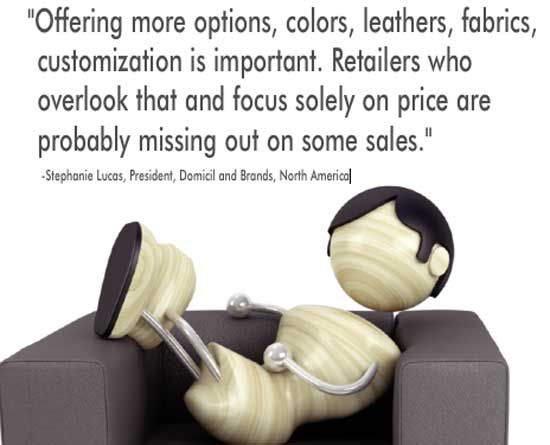
LEATHER GRAIN CORRECTION
As noted previously, the term top grain leather refers to leather that retains the top portion of the hide. Full grain refers to top grain leather that also retains its natural surface markings. Top grain leather that has too many surface imperfections may be processed (corrected) by buffing/sanding the surface to remove objectionable marks. Natural looking patterned effects can then be re-introduced by coating the leather with layers of pigment finish and embossing it under heat or high pressure. This process can smooth the grain or produce unique patterned effects (ostrich, alligator, lizard, etc.). The result is known as corrected grain leather.
LEATHER TANNING
Tanning is the process that turns an animal hide into leather. It preserves the hide, makes it softer, more pliable and durable. Your customers may remember leather, that after several decades of use cracked, eventually revealing reddish, rotted leather underneath the pigmented finish. Says Bruce Nurse, “I would suggest to you that the rotting has less to do with the transparent penetrating vegetable dye and has more to do with the oils and acids from the bodies of the people in the home. After many years, the oils and acids migrate through cracks in the finish and break down the tissue. Weaker cuts of leather saturate and tear.” Today, virtually all leather is tanned with a chromium tanning process which is a type of mineral tanning. With normal use and care, modern chromium tanning techniques produce leather upholstery that can last several decades.
LEATHER DYEING & FINISHING
Tanned leather is first colored with a penetrating dye. The dye permeates the surface of the hide giving it color, but does not cover over natural markings. The leather can then be finished in one or more coating operations, with clear or pigmented finishes that do not penetrate the surface. These final finishes provide abrasion and stain resistance as well as color enhancement. Generally, the more surface finish a leather has, the stiffer (boardier) it becomes, but tanning formula and hide quality also affect leather stiffness.
Aniline dye in common industry usage refers to any dye that penetrates into the leather, coloring it, but not coating its surface with pigment. Virtually all upholstery leathers are initially treated with a penetrating aniline dye that allows the natural grain to show through.
The amount of dye used in leather production depends on the extent to which the dye has penetrated the leather. The dyeing of leather can be controlled by the manufacturer to either fully or partially penetrate it. Leather that has been fully penetrated with dye is known as fully struck through leather. If it has only been superficially dyed (only the flesh and grain surfaces penetrated), it is called partially struck through. For obvious reasons, leather whose cut edges will be exposed in the finished upholstered piece must have the dye fully struck through, but normal wear will not expose the interior of partially struck through leather.
Aniline Leather: Pure aniline leather, sometimes called aniline leather, aniline finish leather or premium select leather, is a product that has a clear protective coating but no applied pigmented surface coating (finish).
This is the best quality and most expensive leather. It is made from hides having a minimum of natural markings which have not needed to be grain corrected, embossed, or coated with pigment. Natural characteristics of the hide show through and the surface is soft and supple. Moderate color variations are normal and these un-pigmented leathers tend to develop a rich patina with age. Only a small percentage of hides are good enough to be converted into pure aniline leather.
Dr. Peter Marino explains that “Since most consumers will not forgive leather its “blemishes,” very few hides, comparatively speaking, are aniline finished (pure aniline). Such finishes are absolutely clear. By analogy, an aniline finish is to leather what the clear lacquers and stains are to wood. But while the grains of wood are not obliterated by sanding to remove scratches and dents, the grains of leather are. The reason is obvious. The grains in wood run throughout; in hides, they do not. Therefore, while clear lacquers and stains are common wood finishes, the opposite is true of leather.”
Semi-Aniline: Semi-aniline leather (aniline plus leather) has not as some believe had less aniline dye used in its manufacture than leather described simply, as aniline leather, pure aniline leather or aniline finished. The term semi-aniline leather describes full grain leather which contains only a small amount of surface coating (finish); a premium product which allows most of the natural character of the leather to show through. It is, therefore, misleading to describe a heavily finished or protected leather as being semi-aniline dyed.
“Whenever anyone recommends aniline or semi-aniline finished leather,” councils Bruce Nurse, “it should always be pointed out that these finishes develop a natural patina very quickly and can stain and/or mark very easily. Oils, hair, skin, etc., even water can permanently stain these finishes if it sits there long enough, sometimes just minutes. The finish is not as durable with respect to stain-resistance as the pigmented finish. The penetrating dyes used are transparent, leaving unique features visible in the hide and the natural patina that ages the leather cover with grace over time.
Protected Aniline: Protected aniline leather is less expensive and more common than pure aniline or semi-aniline leather. Its coloration is more consistent and because it has been coated with protective pigments, the leather’s natural markings are less noticeable. Protected leather is more heavily pigmented than semi-aniline leather and is actually easier to clean than pure aniline leather because surface pigments repel water and stains... standing up well to heavy use. “Fully finished (pigmented) leather covers have a protective polyurethane or poly-acrylic coat that makes it somewhat stain-resistant and easy to clean,”explains Bruce Nurse. “The pigmented dye and poly protective coat gives the leather cover good wear-ability.
The actual dye may be a transparent penetrating dye and an opaque pigment that’s much like a paint coating the surface of the cover “I would suggest that all pigmented finishes have a clear protective polyurethane or poly-acrylic topcoat cured on top of a pigmented dye. Dye in this case can be a misunderstood word; even an overused or wrong word. Pigmented finish is not a penetrating dye; it is like a paint that is spread on the surface. Should someone cause an abrasion through any method, including vigorous cleaning, it will expose a neutral or contrasting color back. Quite frankly, it’s like someone scratching the paint off your car or damaging your drywall. Paint scratched off the pigmented finish of a car will expose the metal substrate. Pigment/paint on drywall, damaged by bumping it or scraping it will expose the substrate behind it.”
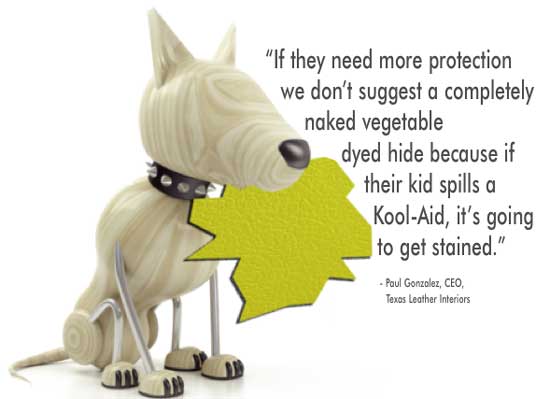
LEATHER MARKET TRENDS
Fine leather upholstery used to be found in the dens and living rooms of only the very wealthy. The category was characterized by heavy, traditional styles and the use of strong colors such as burgundy, oxblood, burnt orange, rust, walnut, tortoise, navy and blackberry. These leathers generally had heavily glazed, shiny finishes. Massive, traditional chesterfields, tufted wing chairs, traditional saddle-arm and double bustle pub sofas characterized leather upholstered furniture styles.
More recently, advances in tanning technology, globalization, the introduction of composite leather materials, and changes in consumer buying preferences have helped leather furniture sales to grow at a tremendous pace.
Contemporary styled leather upholstery has emerged as the growth category with broad consumer appeal. Not only has the styling of upholstered pieces changed, leather now comes in a wider array of designer colors and is generally softer, more pliable and comfortable.
Leather manufacturers and retailers we interviewed told us that there are three major trends in leather furniture today. They see a move toward contemporary styles, the incorporation of motion and younger consumers buying more leather furniture.
"The major current trend that we’re seeing," notes Peter Zolferino, President of Omnia Leather, "is a swing to European contemporary on a smaller scale, very clean lines that include motion, or motorized motion. Some of the growth in contemporary is being driven by younger buyers, and some is due to a shift in the taste level of the overall marketplace. Consumers are looking for reclining seats and adjustable headrests. We’ve seen our motion business increase about 15 percent in the last year. We’re also seeing some different color pallets, nice orange colors and pastels in both leather and fabric. Obviously browns and off whites still sell, and our traditional lines are still strong."
"In general," agrees Arizona Leather’s Jim Riedl. “Cleaner lines on furniture is what people are leaning towards, whether that means contemporary or just an uncluttered, simple design that is timeless. Definitely that is where a lot of our sales are occurring. I just said contemporary, but some of the more traditional looks, scaled down with cleaner lines also appeal to our customers. Another trend we’ve seen in the past 12 to 24 months has been motion furniture, which is on fire. It used to be about 30 percent of our business. Now it’s probably close to 60 percent in reclining sectionals and reclining sofas.
"I think our customers have gotten a little younger," Jim adds. "Prior to five years ago, our customer was 45 to 50 or older, and I think that the age has dropped a little bit to maybe 37 to 55."
"At Texas Leather," Paul Gonzalez tells Furniture World, "Our demographics have always been 30 or 35 to 70. It’s just always been like that. When we open stores, we look for that $80,000 plus income, well educated customer."
"The trends have changed as to who’s buying leather now," agrees Ramona. "When we first started it was an age group of 35 years and older. Now we’re selling leather furniture to first time buyers, kids that are just getting married. There is no target age group now. Our store is in Bakersfield, CA which has become more metropolitan. Younger people come in wanting a more, contemporary uptown look, a New York loft look, a Pottery Barn look. Most consumers come in already knowing the kind of style they want which makes our job easier. They are looking for style first, then comfort and then color. We also see people who buy a rustic urban look and are mixing that in with the contemporary. People used to have an idea that leather furniture had to be, office-like or it had to have hair on it like, the King’s Ranch. The major trend now is going toward more urban and more distressed."
Elaborating on the reasons for consumer interest in motion, Paul Gonzalez at Texas Leather says, "It’s a segment that’s gone up year after year, and now motorized is becoming a major part of that because our customers are spending more time at home with their home theaters and reclining sofas. Especially the baby boomers are buying recliners and going for a little bit more comfort."
"I’m also seeing a big trend for the last two or three years, especially here in Texas, in the growth of the conversation sofa, with more angles, not so linear or L-shaped. We are seeing more curved shapes, and four seated or three seated conversations are a big push for us.”
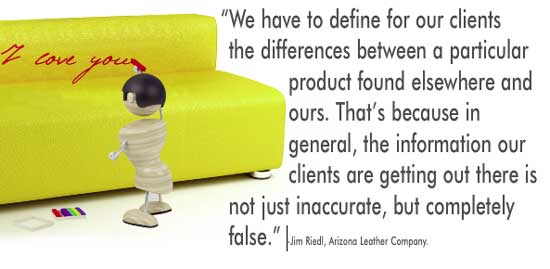
Stephanie Lucas, President, Domicil and Brands North America, sees a shift toward contemporary as well. She says, "Stylistically we see contemporary as a growing category. And when I use the word contemporary I use it loosely. It used to be that you were either a contemporary styled person or traditional. Now what we see is the blending of design, so much so that it’s possible to integrate contemporary into a kind of an eclectic style in one room."
Another trend she sees is that, "Gen X and Gen Y buyers are giving up on the idea that the furniture they buy will last forever. That makes these buyers more open minded. Now customers feel that they have an evolving style and that in five or six years if they’re tired of it they might change it. And, I think overall that’s a good thing for our industry. It’s a consumer mindset that will keep the marketplace fresh and people continuing to shop for furniture.
"She also believes that, "There are more requests right now from people wanting it the way they want it. So, offering more options, colors, leathers, fabrics, customization is important. Retailers who overlook that and focus solely on price are probably missing out on some sales.
"Retailers are less likely to display a sofa, love seat and chair as a matching set," concludes Lucas. She observes that retailers need to make each slot work. "And I think " she says, "it’s by showing as much versatility in that slot on the floor as they possibly can. To do that they might show styles in leather and fabric, perhaps show the sofa in leather, the chair in fabric and an accent chair in a pattern."
NEXT INSTALLMENT: The second part of this series will include information on repair, extended warranties, care and cleaning, a features/advantages chart, and a big glossary of leather terms.
Russell Bienenstock is Editor-in-Chief of Furniture World Magazine, founded 1870. Comments can be directed to him at editor@furninfo.com.